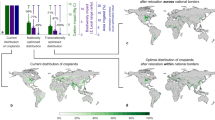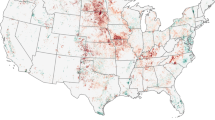Abstract
Greenhouse gas emissions from global agriculture are increasing at around 1% per annum, yet substantial cuts in emissions are needed across all sectors1. The challenge of reducing agricultural emissions is particularly acute, because the reductions achievable by changing farming practices are limited2,3 and are hampered by rapidly rising food demand4,5. Here we assess the technical mitigation potential offered by land sparing—increasing agricultural yields, reducing farmland area and actively restoring natural habitats on the land spared6. Restored habitats can sequester carbon and can offset emissions from agriculture. Using the UK as an example, we estimate net emissions in 2050 under a range of future agricultural scenarios. We find that a land-sparing strategy has the technical potential to achieve significant reductions in net emissions from agriculture and land-use change. Coupling land sparing with demand-side strategies to reduce meat consumption and food waste can further increase the technical mitigation potential—however, economic and implementation considerations might limit the degree to which this technical potential could be realized in practice.
This is a preview of subscription content, access via your institution
Access options
Subscribe to this journal
Receive 12 print issues and online access
$209.00 per year
only $17.42 per issue
Buy this article
- Purchase on Springer Link
- Instant access to full article PDF
Prices may be subject to local taxes which are calculated during checkout



Similar content being viewed by others
References
IPCC Climate Change 2014: Mitigation of Climate Change (eds Edenhofer, O. R. et al.) (Cambridge Univ. Press, 2014).
MacLeod, M. et al. Developing greenhouse gas marginal abatement cost curves for agricultural emissions from crops and soils in the UK. Agric. Syst. 103, 198–209 (2010).
Franks, J. R. & Hadingham, B. Reducing greenhouse gas emissions from agriculture: avoiding trivial solutions to a global problem. Land Use Policy 29, 727–736 (2012).
Tilman, D., Balzer, C., Hill, J. & Befort, B. L. Global food demand and the sustainable intensification of agriculture. Proc. Natl Acad. Sci. USA 108, 20260–20264 (2011).
Alexandratos, N. & Bruinsma, J. World Agriculture Towards 2030/2050: The 2012 Revision (FAO, 2012).
Green, R. E., Cornell, S. J., Scharlemann, J. P. W. & Balmford, A. Farming and the fate of wild nature. Science 307, 550–555 (2005).
Climate Change Act 2008 (The Stationery Office, 2008).
Thornton, P. K. Livestock production: recent trends, future prospects. Phil. Trans. R. Soc. B 365, 2853–2867 (2010).
Lobell, D. B. The case of the missing wheat. Environ. Res. Lett. 7, 021002 (2012).
Alston, J. M., Beddow, J. M. & Pardey, P. G. Agricultural research, productivity, and food prices in the long run. Science 325, 1209–1210 (2009).
Thirtle, C., Lin Lin, L., Holding, J., Jenkins, L. & Piesse, J. Explaining the decline in UK agricultural productivity growth. J. Agric. Econ. 55, 343–366 (2004).
Murrells, T. et al. UK Greenhouse Gas Inventory, 1990 to 2011: Annual Report for Submission Under the Framework Convention on Climate Change (DEFRA, 2013).
IPCC 2006 IPCC Guidelines for National Greenhouse Gas Inventories, Prepared by the National Greenhouse Gas Inventories Programme (eds Eggleston, H. S., Buendia, L., Miwa, K., Ngara, T & Tanabe, K.) (IGES, 2006).
Bajželj, B. et al. Importance of food-demand management for climate mitigation. Nature Clim. Change 4, 924–929 (2014).
IPCC Climate Change 2014: Impacts, Adaptation, and Vulnerability (eds Field, C. B. et al.) (Cambridge Univ. Press, 2014).
McMichael, A. J., Powles, J. W., Butler, C. D. & Uauy, R. Food, livestock production, energy, climate change, and health. Lancet 370, 1253–1263 (2007).
Thow, A. M., Downs, S. & Jan, S. A systematic review of the effectiveness of food taxes and subsidies to improve diets: understanding the recent evidence. Nutr. Rev. 72, 551–565 (2014).
Bateman, I. J. et al. Bringing ecosystem services into economic decision-making: land use in the United Kingdom. Science 341, 45–50 (2013).
Cohn, A. S. et al. Cattle ranching intensification in Brazil can reduce global greenhouse gas emissions by sparing land from deforestation. Proc. Natl Acad. Sci. USA 111, 7236–7241 (2014).
Stevenson, J. R., Villoria, N., Byerlee, D., Kelley, T. & Maredia, M. Green Revolution research saved an estimated 18 to 27 million hectares from being brought into agricultural production. Proc. Natl Acad. Sci. USA 110, 8363–8368 (2013).
Nelson, G. C. & Shively, G. E. Modeling climate change and agriculture: an introduction to the special issue. Agric. Econ. 45, 1–2 (2014).
Smith, P. Soils and climate change. Curr. Opin. Environ. Sustain. 4, 539–544 (2012).
Read, D. J. et al. Combating Climate Change: A Role for UK Forests. An Assessment of the Potential of the UK’s Trees and Woodlands to Mitigate and Adapt to Climate Change (The Stationery Office, 2009).
Fezzi, C., Harwood, A. R., Lovett, A. A. & Bateman, I. J. The environmental impact of climate change adaptation on land use and water quality. Nature Clim. Change 5, 255–260 (2015).
Godfray, H. C. J. & Garnett, T. Food security and sustainable intensification. Phil. Trans. R. Soc. B 369, 20120273 (2014).
Global Forest Resources Assessment: 2010 Main Report (FAO, 2010).
Balmford, A., Green, R. & Phalan, B. What conservationists need to know about farming. Proc. R. Soc. B 279, 2714–2724 (2012).
Phalan, B., Onial, M., Balmford, A. & Green, R. E. Reconciling food production and biodiversity conservation: land sharing and land sparing compared. Science 333, 1289–1291 (2011).
Rowe, R. L., Street, N. R. & Taylor, G. Identifying potential environmental impacts of large-scale deployment of dedicated bioenergy crops in the UK. Renew. Sustain. Energy Rev. 13, 271–290 (2009).
Mueller, N. D. et al. Closing yield gaps through nutrient and water management. Nature 490, 254–257 (2012).
Acknowledgements
This research was funded by the Cambridge Conservation Initiative Collaborative Fund for Conservation, and we thank its major sponsor Arcadia. We thank J. Bruinsma for the provision of demand data, the CEH for the provision of soil data and J. Spencer for invaluable discussions. A.L. was supported by a Gates Cambridge Scholarship. T.B., K.G. and J.P. acknowledge BBSRC funding through grant BBS/E/C/00005198.
Author information
Authors and Affiliations
Contributions
A.B., A.L. and R.G. conceived the study. A.L. conducted the analysis and prepared the manuscript. A.H., D.K., E.W., K.G., P.C., P.S. and R.F. supplied data. All authors contributed in the writing and editing of the manuscript.
Corresponding author
Ethics declarations
Competing interests
The authors declare no competing financial interests.
Rights and permissions
About this article
Cite this article
Lamb, A., Green, R., Bateman, I. et al. The potential for land sparing to offset greenhouse gas emissions from agriculture. Nature Clim Change 6, 488–492 (2016). https://doi.org/10.1038/nclimate2910
Received:
Accepted:
Published:
Issue Date:
DOI: https://doi.org/10.1038/nclimate2910
This article is cited by
-
Farm forests, seasonal hunger, and biomass poverty: Evidence of induced intensification from panel data in the Ethiopian Highlands
Ambio (2024)
-
Potential to improve nitrogen use efficiency (NUE) by use of perennial mobile green manures
Nutrient Cycling in Agroecosystems (2023)
-
Planting trees in livestock landscapes to protect soil and water also delivers carbon sequestration
Agroforestry Systems (2023)
-
Spatial expansion of avocado in Mexico: Could the energy use of pruning residues offset orchard GHG emissions?
Environment, Development and Sustainability (2023)
-
Sparing or expanding? The effects of agricultural yields on farm expansion and deforestation in the tropics
Biodiversity and Conservation (2023)



